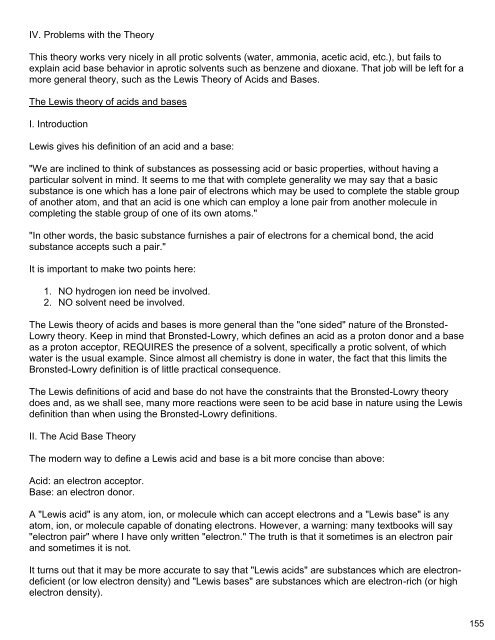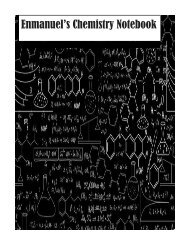You also want an ePaper? Increase the reach of your titles
YUMPU automatically turns print PDFs into web optimized ePapers that Google loves.
IV. Problems with the Theory<br />
This theory works very nicely in all protic solvents (water, ammonia, acetic acid, etc.), but fails to<br />
explain acid base behavior in aprotic solvents such as benzene and dioxane. That job will be left for a<br />
more general theory, such as the Lewis Theory of Acids and Bases.<br />
The Lewis theory of acids and bases<br />
I. Introduction<br />
Lewis gives his definition of an acid and a base:<br />
"We are inclined to think of substances as possessing acid or basic properties, without having a<br />
particular solvent in mind. It seems to me that with complete generality we may say that a basic<br />
substance is one which has a lone pair of electrons which may be used to complete the stable group<br />
of another atom, and that an acid is one which can employ a lone pair from another molecule in<br />
completing the stable group of one of its own atoms."<br />
"In other words, the basic substance furnishes a pair of electrons for a chemical bond, the acid<br />
substance accepts such a pair."<br />
It is important to make two points here:<br />
1. NO hydrogen ion need be involved.<br />
2. NO solvent need be involved.<br />
The Lewis theory of acids and bases is more general than the "one sided" nature of the Bronsted-<br />
Lowry theory. Keep in mind that Bronsted-Lowry, which defines an acid as a proton donor and a base<br />
as a proton acceptor, REQUIRES the presence of a solvent, specifically a protic solvent, of which<br />
water is the usual example. Since almost all chemistry is done in water, the fact that this limits the<br />
Bronsted-Lowry definition is of little practical consequence.<br />
The Lewis definitions of acid and base do not have the constraints that the Bronsted-Lowry theory<br />
does and, as we shall see, many more reactions were seen to be acid base in nature using the Lewis<br />
definition than when using the Bronsted-Lowry definitions.<br />
II. The Acid Base Theory<br />
The modern way to define a Lewis acid and base is a bit more concise than above:<br />
Acid: an electron acceptor.<br />
Base: an electron donor.<br />
A "Lewis acid" is any atom, ion, or molecule which can accept electrons and a "Lewis base" is any<br />
atom, ion, or molecule capable of donating electrons. However, a warning: many textbooks will say<br />
"electron pair" where I have only written "electron." The truth is that it sometimes is an electron pair<br />
and sometimes it is not.<br />
It turns out that it may be more accurate to say that "Lewis acids" are substances which are electrondeficient<br />
(or low electron density) and "Lewis bases" are substances which are electron-rich (or high<br />
electron density).




